xarray IRIS backend#
In this example, we read IRIS (sigmet) data files using the wradlib iris xarray backend.
[1]:
import glob
import gzip
import io
import wradlib as wrl
import warnings
warnings.filterwarnings("ignore")
import matplotlib.pyplot as pl
import numpy as np
import xarray as xr
try:
get_ipython().run_line_magic("matplotlib inline")
except:
pl.ion()
/home/runner/micromamba-root/envs/wradlib-tests/lib/python3.11/site-packages/tqdm/auto.py:22: TqdmWarning: IProgress not found. Please update jupyter and ipywidgets. See https://ipywidgets.readthedocs.io/en/stable/user_install.html
from .autonotebook import tqdm as notebook_tqdm
Load IRIS Volume Data#
[2]:
fpath = "sigmet/SUR210819000227.RAWKPJV"
f = wrl.util.get_wradlib_data_file(fpath)
vol = wrl.io.open_iris_dataset(f, reindex_angle=False)
Downloading file 'sigmet/SUR210819000227.RAWKPJV' from 'https://github.com/wradlib/wradlib-data/raw/pooch/data/sigmet/SUR210819000227.RAWKPJV' to '/home/runner/work/wradlib/wradlib/wradlib-data'.
Inspect RadarVolume#
[3]:
display(vol)
<wradlib.RadarVolume>
Dimension(s): (sweep: 1)
Elevation(s): (0.5)
Inspect root group#
The sweep dimension contains the number of scans in this radar volume. Further the dataset consists of variables (location coordinates, time_coverage) and attributes (Conventions, metadata).
[4]:
vol.root
[4]:
<xarray.Dataset>
Dimensions: (sweep: 1)
Dimensions without coordinates: sweep
Data variables:
volume_number int64 0
platform_type <U5 'fixed'
instrument_type <U5 'radar'
primary_axis <U6 'axis_z'
time_coverage_start <U20 '2021-08-19T00:02:28Z'
time_coverage_end <U20 '2021-08-19 00:02:50Z'
latitude float64 ...
longitude float64 ...
altitude float64 ...
sweep_group_name (sweep) <U7 'sweep_0'
sweep_fixed_angle (sweep) float64 0.5
Attributes:
version: None
title: None
institution: None
references: None
source: None
history: None
comment: im/exported using wradlib
instrument_name: None
fixed_angle: 0.5Inspect sweep group(s)#
The sweep-groups can be accessed via their respective keys. The dimensions consist of range and time with added coordinates azimuth, elevation, range and time. There will be variables like radar moments (DBZH etc.) and sweep-dependend metadata (like fixed_angle, sweep_mode etc.).
[5]:
display(vol[0])
<xarray.Dataset>
Dimensions: (azimuth: 359, range: 833)
Coordinates:
* azimuth (azimuth) float64 0.03021 1.035 2.054 ... 358.0 359.0
elevation (azimuth) float32 ...
rtime (azimuth) datetime64[ns] 2021-08-19T00:02:31.104000 .....
* range (range) float32 150.0 450.0 750.0 ... 2.494e+05 2.498e+05
longitude float64 ...
latitude float64 ...
altitude float64 ...
sweep_mode <U20 ...
time datetime64[ns] 2021-08-19T00:02:28.029000
Data variables: (12/15)
DBTH (azimuth, range) float32 ...
DBZH (azimuth, range) float32 ...
VRADH (azimuth, range) float32 ...
WRADH (azimuth, range) float32 ...
ZDR (azimuth, range) float32 ...
KDP (azimuth, range) float32 ...
... ...
DB_HCLASS2 (azimuth, range) int16 ...
SNRH (azimuth, range) float32 ...
sweep_number int64 ...
prt_mode <U7 ...
follow_mode <U7 ...
sweep_fixed_angle float64 0.5
Attributes:
fixed_angle: 0.5Goereferencing#
[6]:
swp = vol[0].copy().pipe(wrl.georef.georeference_dataset)
Plotting#
[7]:
swp.DBZH.plot.pcolormesh(x="x", y="y")
pl.gca().set_aspect("equal")
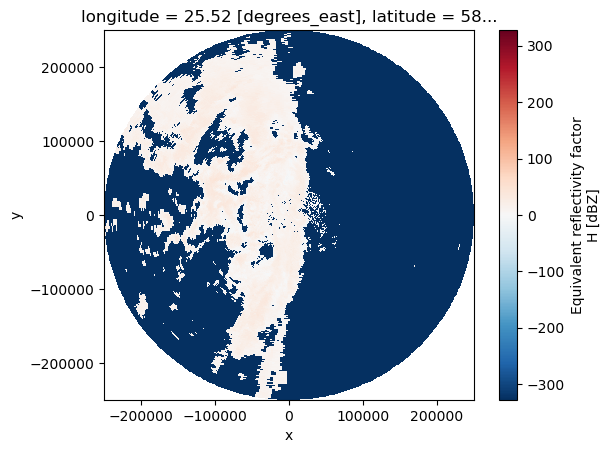
[8]:
fig = pl.figure(figsize=(10, 10))
swp.DBZH.wradlib.plot_ppi(proj="cg", fig=fig)
[8]:
<matplotlib.collections.QuadMesh at 0x7f242921da90>
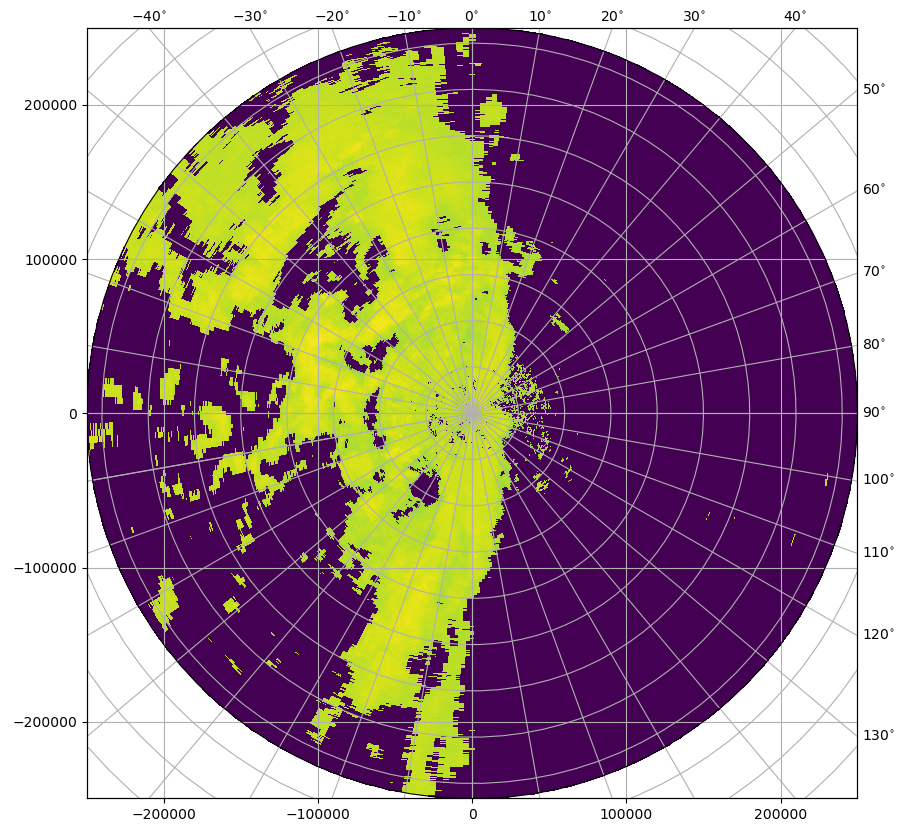
[9]:
import cartopy
import cartopy.crs as ccrs
import cartopy.feature as cfeature
map_trans = ccrs.AzimuthalEquidistant(
central_latitude=swp.latitude.values, central_longitude=swp.longitude.values
)
[10]:
map_proj = ccrs.AzimuthalEquidistant(
central_latitude=swp.latitude.values, central_longitude=swp.longitude.values
)
pm = swp.DBZH.wradlib.plot_ppi(proj=map_proj)
ax = pl.gca()
ax.gridlines(crs=map_proj)
print(ax)
< GeoAxes: +proj=aeqd +ellps=WGS84 +lon_0=25.518660116940737 +lat_0=58.48231002688408 +x_0=0.0 +y_0=0.0 +no_defs +type=crs >
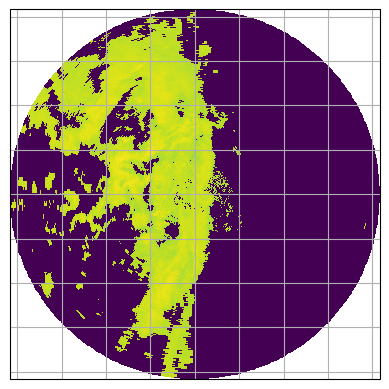
[11]:
map_proj = ccrs.Mercator(central_longitude=swp.longitude.values)
fig = pl.figure(figsize=(10, 8))
ax = fig.add_subplot(111, projection=map_proj)
pm = swp.DBZH.wradlib.plot_ppi(ax=ax)
ax.gridlines(draw_labels=True)
[11]:
<cartopy.mpl.gridliner.Gridliner at 0x7f24291d22d0>

[12]:
import cartopy.feature as cfeature
def plot_borders(ax):
borders = cfeature.NaturalEarthFeature(
category="physical", name="coastline", scale="10m", facecolor="none"
)
ax.add_feature(borders, edgecolor="black", lw=2, zorder=4)
map_proj = ccrs.Mercator(central_longitude=swp.longitude.values)
fig = pl.figure(figsize=(10, 8))
ax = fig.add_subplot(111, projection=map_proj)
DBZH = swp.DBZH
pm = DBZH.where(DBZH > 0).wradlib.plot_ppi(ax=ax)
plot_borders(ax)
ax.gridlines(draw_labels=True)
[12]:
<cartopy.mpl.gridliner.Gridliner at 0x7f241d9c0bd0>
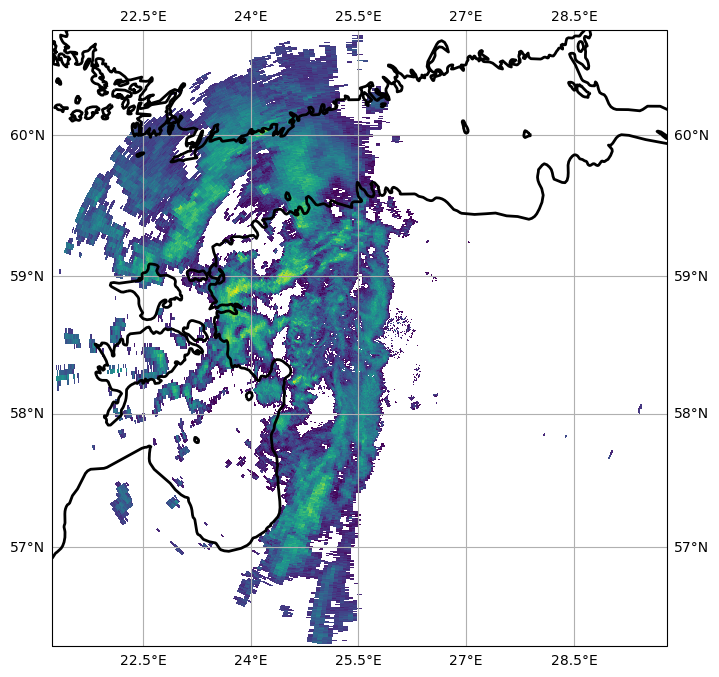
[13]:
import matplotlib.path as mpath
theta = np.linspace(0, 2 * np.pi, 100)
center, radius = [0.5, 0.5], 0.5
verts = np.vstack([np.sin(theta), np.cos(theta)]).T
circle = mpath.Path(verts * radius + center)
map_proj = ccrs.AzimuthalEquidistant(
central_latitude=swp.latitude.values,
central_longitude=swp.longitude.values,
)
fig = pl.figure(figsize=(10, 8))
ax = fig.add_subplot(111, projection=map_proj)
ax.set_boundary(circle, transform=ax.transAxes)
pm = swp.DBZH.wradlib.plot_ppi(proj=map_proj, ax=ax)
ax = pl.gca()
ax.gridlines(crs=map_proj)
[13]:
<cartopy.mpl.gridliner.Gridliner at 0x7f241d856310>

[14]:
fig = pl.figure(figsize=(10, 8))
proj = ccrs.AzimuthalEquidistant(
central_latitude=swp.latitude.values, central_longitude=swp.longitude.values
)
ax = fig.add_subplot(111, projection=proj)
pm = swp.DBZH.wradlib.plot_ppi(ax=ax)
ax.gridlines()
[14]:
<cartopy.mpl.gridliner.Gridliner at 0x7f241d7459d0>
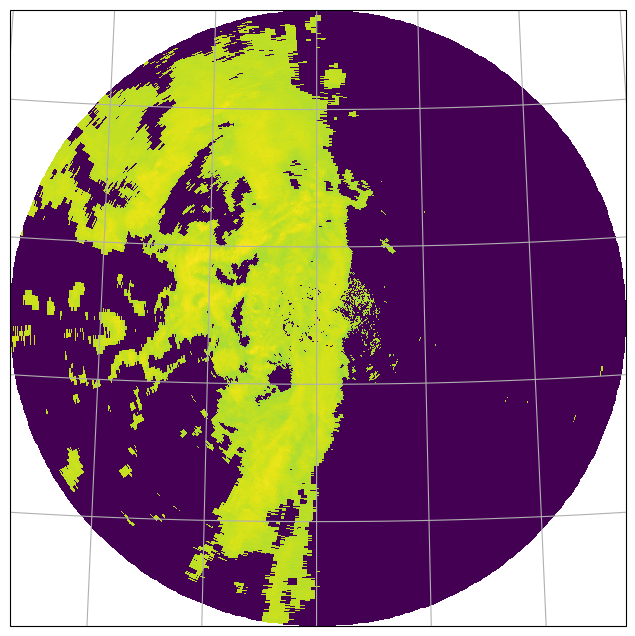
[15]:
swp.DBZH.wradlib.plot_ppi()
[15]:
<matplotlib.collections.QuadMesh at 0x7f24292a5f10>
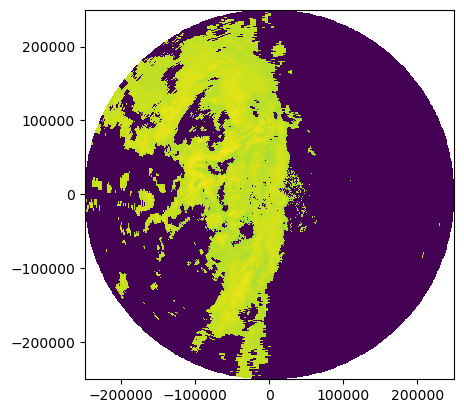
Inspect radar moments#
The DataArrays can be accessed by key or by attribute. Each DataArray has dimensions and coordinates of it’s parent dataset.
[16]:
display(swp.DBZH)
<xarray.DataArray 'DBZH' (azimuth: 359, range: 833)>
array([[-327.68, -327.68, -327.68, ..., -327.68, -327.68, -327.68],
[-327.68, 3.39, 6.45, ..., -327.68, -327.68, -327.68],
[ -8.86, 5.25, 8.58, ..., -327.68, -327.68, -327.68],
...,
[-327.68, -327.68, -327.68, ..., -327.68, -327.68, -327.68],
[-327.68, 4.75, 10.95, ..., -327.68, -327.68, -327.68],
[-327.68, -327.68, 4.94, ..., -327.68, -327.68, -327.68]])
Coordinates: (12/15)
* azimuth (azimuth) float64 0.03021 1.035 2.054 ... 357.0 358.0 359.0
elevation (azimuth) float64 0.5054 0.5054 0.5054 ... 0.5054 0.5054 0.5054
rtime (azimuth) datetime64[ns] 2021-08-19T00:02:31.104000 ... 2021-...
* range (range) float32 150.0 450.0 750.0 ... 2.494e+05 2.498e+05
longitude float64 25.52
latitude float64 58.48
... ...
x (azimuth, range) float64 0.07909 0.2373 ... -4.211e+03
y (azimuth, range) float64 150.0 450.0 ... 2.493e+05 2.496e+05
z (azimuth, range) float64 158.3 161.0 ... 6.023e+03 6.034e+03
gr (azimuth, range) float64 150.0 450.0 ... 2.493e+05 2.496e+05
rays (azimuth, range) float64 0.03021 0.03021 0.03021 ... 359.0 359.0
bins (azimuth, range) float32 150.0 450.0 ... 2.494e+05 2.498e+05
Attributes:
standard_name: radar_equivalent_reflectivity_factor_h
units: dBZ
long_name: Equivalent reflectivity factor H
coordinates: elevation azimuth range latitude longitude altitude time ...Create simple plot#
Using xarray features a simple plot can be created like this. Note the sortby('rtime') method, which sorts the radials by time.
[17]:
swp.DBZH.sortby("rtime").plot(x="range", y="rtime", add_labels=False)
[17]:
<matplotlib.collections.QuadMesh at 0x7f24292bef90>
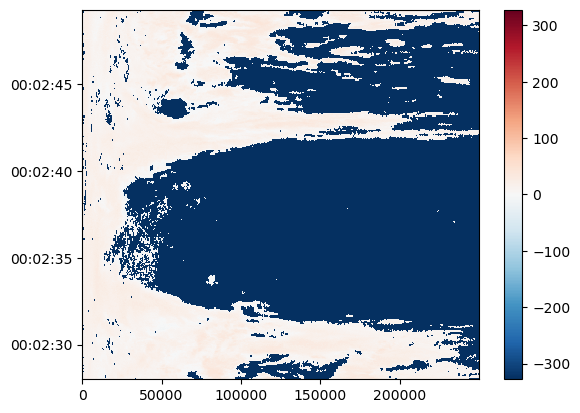
[18]:
fig = pl.figure(figsize=(5, 5))
pm = swp.DBZH.wradlib.plot_ppi(proj={"latmin": 3e3}, fig=fig)
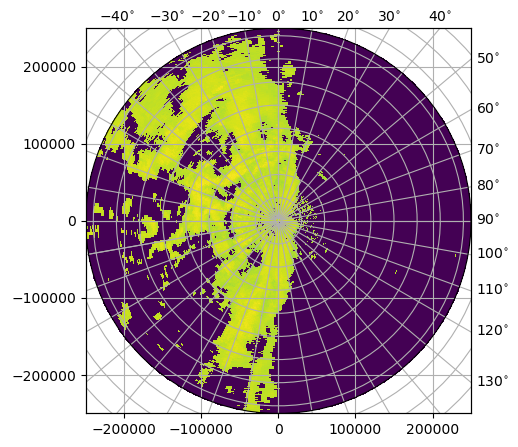
Mask some values#
[19]:
dbzh = swp["DBZH"].where(swp["DBZH"] >= 0)
dbzh.plot(x="x", y="y")
[19]:
<matplotlib.collections.QuadMesh at 0x7f241d763910>

[20]:
vol[0]
[20]:
<xarray.Dataset>
Dimensions: (azimuth: 359, range: 833)
Coordinates:
* azimuth (azimuth) float64 0.03021 1.035 2.054 ... 358.0 359.0
elevation (azimuth) float32 ...
rtime (azimuth) datetime64[ns] 2021-08-19T00:02:31.104000 .....
* range (range) float32 150.0 450.0 750.0 ... 2.494e+05 2.498e+05
longitude float64 ...
latitude float64 ...
altitude float64 ...
sweep_mode <U20 ...
time datetime64[ns] 2021-08-19T00:02:28.029000
Data variables: (12/15)
DBTH (azimuth, range) float32 ...
DBZH (azimuth, range) float32 ...
VRADH (azimuth, range) float32 ...
WRADH (azimuth, range) float32 ...
ZDR (azimuth, range) float32 ...
KDP (azimuth, range) float32 ...
... ...
DB_HCLASS2 (azimuth, range) int16 ...
SNRH (azimuth, range) float32 ...
sweep_number int64 ...
prt_mode <U7 ...
follow_mode <U7 ...
sweep_fixed_angle float64 0.5
Attributes:
fixed_angle: 0.5Export to ODIM and CfRadial2#
Need to remove DB_XHDR since it can’t be represented as ODIM/CfRadial2 moment.
[21]:
vol[0] = vol[0].drop("DB_XHDR", errors="ignore")
vol[0].DBZH.sortby("rtime").plot(y="rtime")
[21]:
<matplotlib.collections.QuadMesh at 0x7f2428da8810>
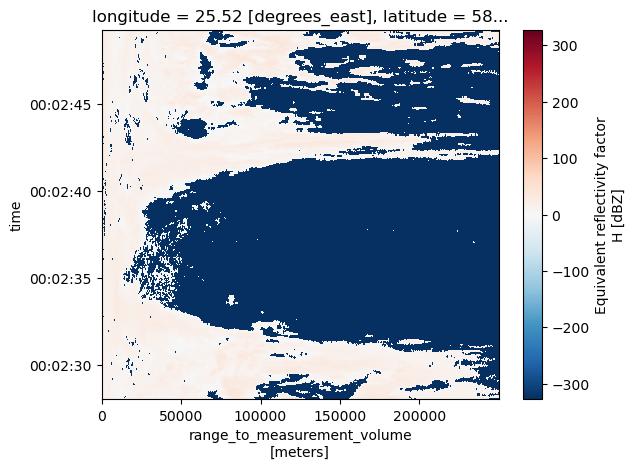
[22]:
vol.to_odim("iris_as_odim.h5")
vol.to_cfradial2("iris_as_cfradial2.nc")
Import again#
[23]:
vola = wrl.io.open_odim_dataset(
"iris_as_odim.h5", reindex_angle=False, keep_elevation=True
)
display(vola.root)
display(vola[0])
vola[0].DBZH.sortby("rtime").plot(y="rtime")
<xarray.Dataset>
Dimensions: (sweep: 1)
Dimensions without coordinates: sweep
Data variables:
volume_number int64 0
platform_type <U5 'fixed'
instrument_type <U5 'radar'
primary_axis <U6 'axis_z'
time_coverage_start <U20 '2021-08-19T00:02:28Z'
time_coverage_end <U20 '2021-08-19 00:02:50Z'
latitude float64 ...
longitude float64 ...
altitude float64 ...
sweep_group_name (sweep) <U7 'sweep_0'
sweep_fixed_angle (sweep) float64 0.5
Attributes:
version: None
title: None
institution: None
references: None
source: None
history: None
comment: im/exported using wradlib
instrument_name: None
fixed_angle: 0.5<xarray.Dataset>
Dimensions: (azimuth: 359, range: 833)
Coordinates:
* azimuth (azimuth) float64 0.03021 1.035 2.054 ... 358.0 359.0
elevation (azimuth) float64 ...
rtime (azimuth) datetime64[ns] 2021-08-19T00:02:31.104000 .....
* range (range) float32 150.0 450.0 750.0 ... 2.494e+05 2.498e+05
sweep_mode <U20 ...
longitude float64 ...
latitude float64 ...
altitude float64 ...
time datetime64[ns] 2021-08-19T00:02:28.028999936
Data variables: (12/15)
DBTH (azimuth, range) float32 ...
DB_HCLASS2 (azimuth, range) int16 ...
SNRH (azimuth, range) float32 ...
DBZH (azimuth, range) float32 ...
VRADH (azimuth, range) float32 ...
WRADH (azimuth, range) float32 ...
... ...
SQIH (azimuth, range) float32 ...
PHIDP (azimuth, range) float32 ...
sweep_number int64 ...
prt_mode <U7 ...
follow_mode <U7 ...
sweep_fixed_angle float64 0.5
Attributes:
fixed_angle: 0.5[23]:
<matplotlib.collections.QuadMesh at 0x7f241d40f1d0>

[24]:
volb = wrl.io.open_cfradial2_dataset("iris_as_cfradial2.nc")
display(volb.root)
display(volb[0])
volb[0].DBZH.sortby("rtime").plot(y="rtime")
<xarray.Dataset>
Dimensions: (sweep: 1)
Dimensions without coordinates: sweep
Data variables:
volume_number int64 0
platform_type <U5 'fixed'
instrument_type <U5 'radar'
primary_axis <U6 'axis_z'
time_coverage_start <U20 '2021-08-19T00:02:28Z'
time_coverage_end <U20 '2021-08-19 00:02:50Z'
latitude float64 ...
longitude float64 ...
altitude float64 ...
sweep_group_name (sweep) <U7 'sweep_0'
sweep_fixed_angle (sweep) float64 0.5
Attributes:
version: None
title: None
institution: None
references: None
source: None
history: None
comment: im/exported using wradlib
instrument_name: None
fixed_angle: 0.5<xarray.Dataset>
Dimensions: (azimuth: 359, range: 833)
Coordinates:
* azimuth (azimuth) float64 0.03021 1.035 2.054 ... 358.0 359.0
elevation (azimuth) float32 ...
rtime (azimuth) datetime64[ns] 2021-08-19T00:02:31.104000 .....
* range (range) float32 150.0 450.0 750.0 ... 2.494e+05 2.498e+05
longitude float64 ...
latitude float64 ...
altitude float64 ...
sweep_mode <U20 ...
time datetime64[ns] 2021-08-19T00:02:28.029000
Data variables: (12/15)
DBTH (azimuth, range) float32 ...
DBZH (azimuth, range) float32 ...
VRADH (azimuth, range) float32 ...
WRADH (azimuth, range) float32 ...
ZDR (azimuth, range) float32 ...
KDP (azimuth, range) float32 ...
... ...
DB_HCLASS2 (azimuth, range) int16 ...
SNRH (azimuth, range) float32 ...
sweep_number int64 ...
prt_mode object ...
follow_mode object ...
sweep_fixed_angle float64 0.5
Attributes:
fixed_angle: 0.5[24]:
<matplotlib.collections.QuadMesh at 0x7f241d2422d0>

Check equality#
We have to drop the time variable when checking equality since IRIS has millisecond resolution.
[25]:
xr.testing.assert_allclose(vol.root, vola.root)
xr.testing.assert_allclose(
vol[0].drop(["rtime", "time"]), vola[0].drop(["rtime", "time"])
)
xr.testing.assert_allclose(vol.root, volb.root)
xr.testing.assert_allclose(vol[0], volb[0])
xr.testing.assert_allclose(vola.root, volb.root)
xr.testing.assert_allclose(
vola[0].drop(["rtime", "time"]), volb[0].drop(["rtime", "time"])
)
More Iris loading mechanisms#
Use xr.open_dataset to retrieve explicit group#
Warning
Since \(\omega radlib\) version 1.18 the xarray backend engines for polar radar data have been renamed and prepended with wradlib- (eg. iris -> wradlib-iris). This was necessary to avoid clashes with the new xradar-package, which will eventually replace the wradlib engines. Users have to make sure to check which engine to use for their use-case when using xarray.open_dataset. Users might install and test xradar, and check if it is
already robust enough for their use-cases (by using xradar’s engine="iris".
Since \(\omega radlib\) version 1.19 the xarray backend engines for polar radar data have been deprecated. The functionality is kept until wradlib version 2.0, when the backend-code will be removed completely. wradlib is importing that functionality from xradar-package whenever and wherever necessary.
Below we use a compatibility layer in wradlib to give users the chance to adapt their code. The first minimal change is that for every backend the group-layout is conforming to the CfRadial-standard naming scheme (sweep_0, sweep_1, etc.).
Below you can inspect the main differences of the wradlib compatibility layer and the plain xradar implementation.
use wradlib compatibility layer#
[26]:
swp_a = xr.open_dataset(
f, engine="wradlib-iris", group="sweep_0", backend_kwargs=dict(reindex_angle=False)
)
display(swp_a)
<xarray.Dataset>
Dimensions: (azimuth: 359, range: 833)
Coordinates:
* azimuth (azimuth) float64 0.03021 1.035 2.054 ... 358.0 359.0
elevation (azimuth) float32 ...
rtime (azimuth) datetime64[ns] ...
* range (range) float32 150.0 450.0 750.0 ... 2.494e+05 2.498e+05
longitude float64 ...
latitude float64 ...
altitude float64 ...
sweep_mode <U20 ...
time datetime64[ns] ...
Data variables: (12/15)
DBTH (azimuth, range) float32 ...
DBZH (azimuth, range) float32 ...
VRADH (azimuth, range) float32 ...
WRADH (azimuth, range) float32 ...
ZDR (azimuth, range) float32 ...
KDP (azimuth, range) float32 ...
... ...
DB_HCLASS2 (azimuth, range) int16 ...
SNRH (azimuth, range) float32 ...
sweep_number int64 ...
prt_mode <U7 ...
follow_mode <U7 ...
sweep_fixed_angle float64 ...
Attributes:
fixed_angle: 0.5use xradar backend#
[27]:
swp_b = xr.open_dataset(
f, engine="iris", group="sweep_0", backend_kwargs=dict(reindex_angle=False)
)
display(swp_b)
<xarray.Dataset>
Dimensions: (azimuth: 359, range: 833)
Coordinates:
* azimuth (azimuth) float64 0.03021 1.035 2.054 ... 358.0 359.0
elevation (azimuth) float32 ...
time (azimuth) datetime64[ns] ...
* range (range) float32 150.0 450.0 750.0 ... 2.494e+05 2.498e+05
longitude float64 ...
latitude float64 ...
altitude float64 ...
Data variables: (12/16)
DBTH (azimuth, range) float32 ...
DBZH (azimuth, range) float32 ...
VRADH (azimuth, range) float32 ...
WRADH (azimuth, range) float32 ...
ZDR (azimuth, range) float32 ...
KDP (azimuth, range) float32 ...
... ...
SNRH (azimuth, range) float32 ...
sweep_mode <U20 ...
sweep_number int64 ...
prt_mode <U7 ...
follow_mode <U7 ...
sweep_fixed_angle float64 ...